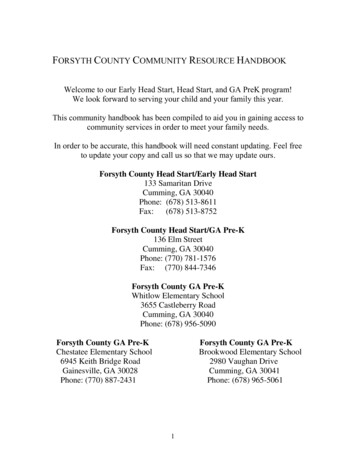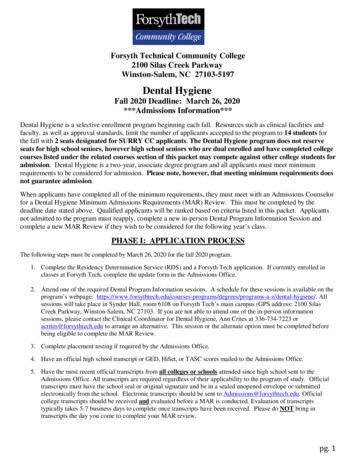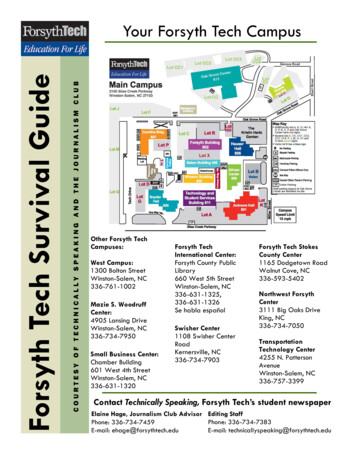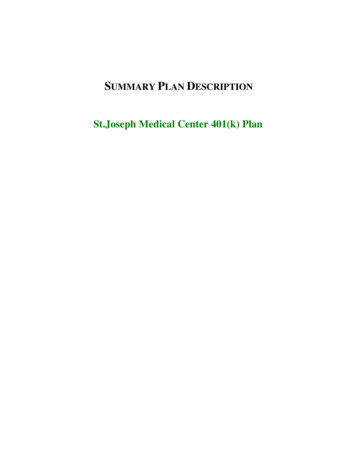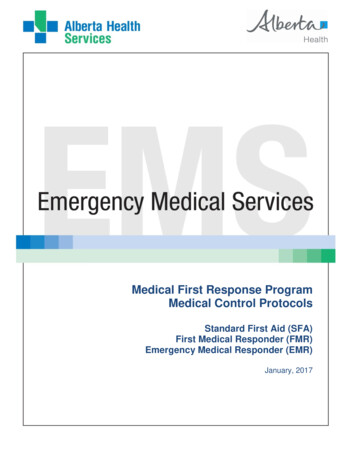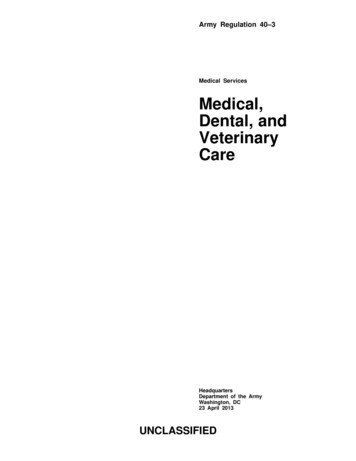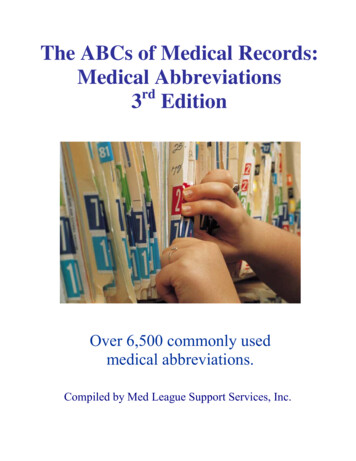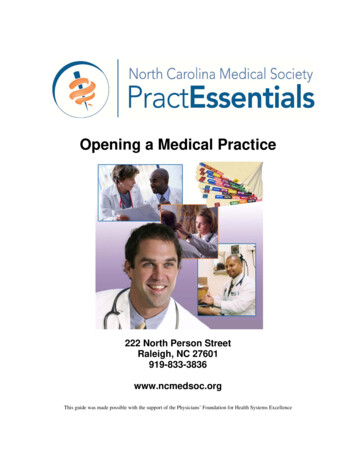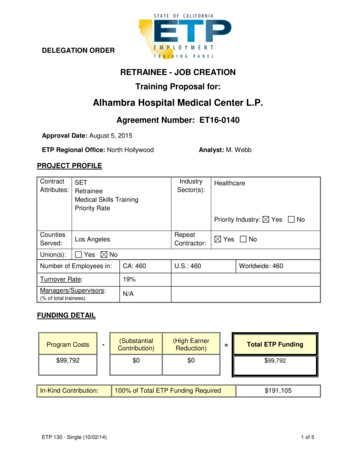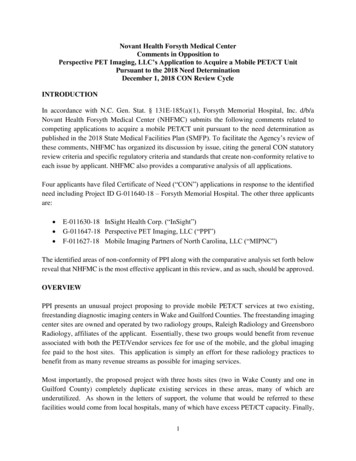
Transcription
Novant Health Forsyth Medical CenterComments in Opposition toPerspective PET Imaging, LLC’s Application to Acquire a Mobile PET/CT UnitPursuant to the 2018 Need DeterminationDecember 1, 2018 CON Review CycleINTRODUCTIONIn accordance with N.C. Gen. Stat. § 131E-185(a)(1), Forsyth Memorial Hospital, Inc. d/b/aNovant Health Forsyth Medical Center (NHFMC) submits the following comments related tocompeting applications to acquire a mobile PET/CT unit pursuant to the need determination aspublished in the 2018 State Medical Facilities Plan (SMFP). To facilitate the Agency’s review ofthese comments, NHFMC has organized its discussion by issue, citing the general CON statutoryreview criteria and specific regulatory criteria and standards that create non-conformity relative toeach issue by applicant. NHFMC also provides a comparative analysis of all applications.Four applicants have filed Certificate of Need (“CON”) applications in response to the identifiedneed including Project ID G-011640-18 – Forsyth Memorial Hospital. The other three applicantsare: E-011630-18 InSight Health Corp. (“InSight”)G-011647-18 Perspective PET Imaging, LLC (“PPI”)F-011627-18 Mobile Imaging Partners of North Carolina, LLC (“MIPNC”)The identified areas of non-conformity of PPI along with the comparative analysis set forth belowreveal that NHFMC is the most effective applicant in this review, and as such, should be approved.OVERVIEWPPI presents an unusual project proposing to provide mobile PET/CT services at two existing,freestanding diagnostic imaging centers in Wake and Guilford Counties. The freestanding imagingcenter sites are owned and operated by two radiology groups, Raleigh Radiology and GreensboroRadiology, affiliates of the applicant. Essentially, these two groups would benefit from revenueassociated with both the PET/Vendor services fee for use of the mobile, and the global imagingfee paid to the host sites. This application is simply an effort for these radiology practices tobenefit from as many revenue streams as possible for imaging services.Most importantly, the proposed project with three hosts sites (two in Wake County and one inGuilford County) completely duplicate existing services in these areas, many of which areunderutilized. As shown in the letters of support, the volume that would be referred to thesefacilities would come from local hospitals, many of which have excess PET/CT capacity. Finally,1
PPI’s projected utilization is unreasonable and unrealistically assumes patients would travelextensive distances to PPI’s affiliated host sites bypassing numerous existing mobile and fixedPET/CT services. As a result of these flaws, PPI’s application is non-conforming with numerousReview Criteria and cannot be approved.NON-CONFORMITY WITH REVIEW CRITERIACriterion (1)“The proposed project shall be consistent with applicable policies and need determinations in theState Medical Facilities Plan, the need determination of which constitutes a determinativelimitation on the provision of any health service, health service facility, health service facility beds,dialysis stations, operating rooms, or home health offices that may be approved.”PPI should be found non-conforming with Criterion (1) because it does not improve safety andquality of care, promote equitable access, or maximize healthcare value as required by PolicyGEN-3. First, PPI is made up of existing radiology imaging centers and physicians’ offices withno experience providing mobile or PET/CT services, raising questions about its ability to providequality care. As previously established, PPI is made up of existing radiology imaging centers orphysicians’ offices with no experience providing mobile services. As such, PPI proposes to obtaincontracts for essentially every component of the mobile PET/CT service, including transportationservices, all staff, including technologists and management, billing and scheduling, digital imagingtransmission, and equipment maintenance.PPI passes along the responsibility of staffing and managing the mobile unit to the host site, whichaffects PPI’s ability to control quality of care delivered. One may argue that PPI is serving its ownradiology centers as host sites and as such, can control quality of care; however, PPI neverexplicitly states that it intends to only serve affiliated sites. In fact, PPI states in its application thatit plans to serve other radiology imaging centers in the future. Regardless, the host sites identifiedin the PPI application have no experience with staffing and managing fixed or mobile PETimaging.PPI states that it will “provide functions, such as management, imaging equipment quality control,regulatory compliance, and staff quality that are in its areas of expertise” (PPI Application, SectionC, page 42); however, according to Form H, both management and staffing will be contracted, andmaintenance of equipment will be contracted (PPI Application, Section C, page 40). Essentially,it appears that PPI itself is only proposing to provide a mobile PET/CT unit, leaving the operation,management, and quality control procedures to the host sites and the companies with which PPIcontracts its services. Contracting a majority of the components of the PET/CT service, especiallystaffing to host sites with no PET experience, most certainly brings into question PPI’s ability tocontrol the quality of care provided.2
Without experience offering mobile PET/CT services as either a vendor or through the proposedaffiliated fixed site, quality is questionable particularly when management and support servicesare not already established when mobile services are provided to a hospital host site. This is notto say that a freestanding site is inappropriate for mobile PET/CT services; however, without moredocumentation of the qualifications, experience, and management expertise, the quality of care atPPI’s affiliate host sites has not been documented.Second, PPI does not expand equitable access as PPI proposes to serve sites in Guilford and WakeCounties located in HSA II and IV respectively. The counties in which the proposed sites arelocated already have ample access to PET/CT services including fixed hospital PET/CT units withexcess unused capacity. Not one of PPI’s proposed host sites is actually expanding geographicaccess to care or alleviating capacity constraints. Certainly, the proposed access does not maximizehealthcare value by serving sites that already have adequate access to PET/CT services.Based on these issues, PPI’s application is not consistent with Policy GEN-3 and should be foundnon-conforming with Criterion (1).Criterion (3)“The applicant shall identify the population to be served by the proposed project, and shalldemonstrate the need that this population has for the services proposed, and the extent to whichall residents of the area, and, in particular, low income persons, racial and ethnic minorities,women, handicapped persons, the elderly, and other underserved groups are likely to have accessto the services proposed.”PPI should be found non-conforming with Criterion (3) based on an inappropriately definedservice area and population to be served, unreasonable and unrealistic utilization projections andfailure to expand accessibility to the population it proposes to serve.PPI will not Increase Access to CarePPI proposes to serve two host sites in Wake County and one host site in Guilford County. Exhibit1 below provides a map of the existing fixed and mobile units in Health Service Areas II and IVwhere PPI’s proposed host sites will be located.PPI’s host site in Guilford County is less than one mile away from Cone Health, which has anexisting fixed unit with ample capacity as will be shown below. More importantly, HSA IV andWake County, where two of PPI’s proposed sites are located, have the most access to PET/CTservices out of all HSAs with four fixed units, three mobile sites, one additional approved fixedunit at Duke Raleigh Hospital, and published need in the 2019 SMFP for a sixth fixed unit. Note3
that PPI’s proposed “home host site,” Raleigh Radiology Blue Ridge, is also less than a mile fromRex Hospital which has two fixed units on site.It is clear that PPI will not enhance geographic access to PET/CT services and will in fact duplicateexisting capacity at immediately adjacent hospital PET/CT locations.4
Exhibit 1Map of Existing Providers and PPI Proposed Host Sites5
PPI’s Service Area is Unreasonably Defined and InappropriatePPI’s projected utilization is unreasonable. First, PPI provides the historical patient origin for alloutpatient sites of the members. Raleigh Radiology has six locations; however, only one of theseexisting locations is a proposed PPI host site: Raleigh Radiology Blue Ridge (Raleigh RadiologyFuquay Varina opens in January 2019). PPI uses the historical patient origin for all six locationsas a basis for its projected utilization at the Raleigh Radiology host sites. This is inappropriate. Itwould have been more appropriate to present patient origin by site. Nonetheless, this historicalimaging patient origin is more reasonable than the projected patient origin for PET/CT services,which appears to have no meaningful relationship to the location of the proposed host sites,reasonable travel access for PET/CT services, or the referral sources from which PPI willpurportedly gain its projected utilization.The irrationality of PPI’s service area and projected patient origin stands in direct contrast to thehistorical imaging services patient origin for PPI’s affiliated host sites as shown in Exhibit 2. Eachpractice has essentially a single county primary service area – Wake County for Raleigh Radiologyand Guilford County for Greensboro Radiology – and at most three other counties as a secondaryservice area comprising well over 95 percent of each practice’s patient origin.Exhibit 2Historical Patient Origin and Service Area Definition for PPI Host SitesRaleighGreensboroRadiology %Radiology %Alamance3.07%Other NC Counties2.84%Other NC Counties4.73%Out of State3.89%Out of State2.55%Total100.00%Total100.00%Source: PPI CON Pages 46-48.By contrast, PPI claims a service area encompassing patients in 42 different counties across thestate based on the host sites. PPI says as much in Section Q Page 24 of its application: “Theapplicant assumes that the current patient origin patterns are a reasonable proxy for PET imagingpatient patterns at the proposed host sites”; however, PPI’s projected patient origin bears noresemblance to the historical patient origin of Raleigh Radiology or Greensboro Radiology asshown in Exhibit 3.6
Exhibit 3Projected Patient Origin and Service Area Definition for PPI Host combeNew HanoverCabarrusOnslowPittRobesonOther NC CountiesOut of StateTotalRaleigh RadiologyBlue Ridge %% From Historic ServiceArea% From Total OutsideHistoric AreaSource: PPI CON Pages keJohnstonHarnettDurhamMecklenburgBuncombeNew HanoverCabarrusOnslowPittRobesonOther NC CountiesOut of StateTotal% From Historic ServiceArea% From Total OutsideHistoric AreaRaleigh RadilogyFuquay Variana iology .97%Other NC Counties9.48%Out of State3.93%Total100.00%% From HistoricService Area% From TotalOutside Historic Area47.01%52.99%Again, it is unreasonable to assume that a material number of patients from all over the state willtravel past existing host sites to a new PET/CT vendor that is not affiliated with any existingoncology specialty program for PET/CT services and that has no experience offering mobilePET/CT services. For instance, PPI includes Buncombe County in its target counties for PET/CTservices (PPI Application, Section Q, page 31), but no host site in Buncombe County is includedin the PPI application. Buncombe County has access to comprehensive oncology services atMission Hospital and is a minimum of 240 miles or 3.5 hours away from Raleigh Radiology BlueRidge, where PPI proposes these patients will be served. On the far east side of the state, PPIproposes to draw patients from New Hanover and Onslow Counties. This implies that patients willendure more than a two-hour drive, approximately 136 - 145 miles across the state, when there areexisting closer options at New Hanover Regional Medical Center and Onslow Medical Center forPET/CT services.Most notably, PPI projects more patients to drive from Mecklenburg County to the two RaleighRadiology locations, than from Wake County. Both Raleigh Radiology host sites project that 27.43percent of its patients will come from Mecklenburg County, and 22.8 percent of its patients willcome from Wake County. However, historically, 0.1 percent of its patients have been fromMecklenburg County, and 87.16 percent of its patients have originated from Wake County (PPIApplication pages 45-47). The Greensboro host site is expected to capture over 16 percent of itspatients from Mecklenburg County, when historically 0.3 percent of Greensboro Radiologypatients have come from Mecklenburg County (PPI Application page 48). The projected patientorigin does not align with historical experience and referral patterns for the same physicianssupporting the project, and it does not make geographical sense. Also, Mecklenburg County has7
three fixed PET scanners and two mobile host sites. Patients from Mecklenburg County are notgoing to drive to Greensboro or Raleigh for a PET scan.Similar issues can be found in the Greensboro Radiology projected patient origin. In its homecounty of Guilford, PPI only projects 37.89 percent for patient origin. Historically, over 77 percentof patients have originated from Guilford (PPI Application pages 54-55). Likewise, PPI projects16.8 percent of its patients will originate from Mecklenburg County when, historically, only 0.03percent have originated from Mecklenburg County (PPI Application, Section C, Page 48). For theGreensboro location, PPI projects no patients from Alamance County and less than 1 percent ofits patients from Rockingham County despite the fact that 10.72 percent of patients have comefrom these two counties historically (PPI Application pages 48, 54-55). There are many otherexamples of other counties from which PPI proposes to serve a significant number of patients thatare well over 100 miles away from the host sites.PPI provides a list of existing providers and the number of PET patients by county of origin inExhibit E.1 as further proof that patients in need of PET/CT services will travel for care. Contrarily,this exhibit only reiterates the point that for most mobile sites the vast majority of patients comefrom the home county or neighboring counties. Several hospitals with fixed units draw patientsfrom a larger population base due to their status as a provider of comprehensive healthcare servicesand/or their existing oncology programs. PPI is a proposed mobile vendor with no experienceoperating a mobile PET/CT program and independent of any hospital affiliation. It certainlycannot be compared to existing hospitals that offer comprehensive cancer care and draw patientsfrom a broader base. Furthermore, the physicians supporting the project are based on Guilford andWake Counties and do not provide any information to suggest they would refer patients fromdistance locations including Buncombe, Mecklenburg, and New Hanover Counties for example.It is clear that PPI’s projected patient origin is highly flawed and unreasonable and as a result itsprojected service area is unrealistic. PPI fails to appropriately document the population it proposesto serve.PPI’s Utilization Projections are Completely FlawedPPI indulges in a 19-step, multi-faceted exercise to arrive at its projected utilization. However, adetailed analysis of PPI’s project utilization reveals major flaws that deem the projected utilizationunreasonable and unsupported. The patient origin discussion above reveals that the results of the19-step projection model are impracticable and unsound. The most important flaws are detailedbelow.First, PPI uses statewide use rates and applies these rates to the estimated county population todetermine the number of patients by county by year. This assumption implies that the use rate for8
the entire state is indicative of the use rates in each county, which is simply not true as shown inPPI’s own Table 4, Section Q. The assumption that demand will be equal across all counties andthat need can be calculated as such is unrealistic (Table 7, Section Q) This assumption andcalculation of unmet need by county may point out where patients have less access to PET/CTservices, but there is a complete disconnect between this calculation and any assumption that PPIwill serve these patients, increasing PET/CT use rates uniformly to the statewide average (Table10, Section Q).In Step 14, Table 22 of its projected utilization, PPI does not account for the need published in the2019 SMFP for a fixed unit in HSA IV, which will most certainly affect the identified unmet need.In Step 16 of its projected utilization, PPI assumes a 35 percent, 45 percent, and 60 percent marketshare of unmet need in Year 1, 2, and 3 respectively. However, this market share is extremelyaggressive considering that PPI is a new provider with no experience in PET/CT services in anarea already saturated with existing providers. Furthermore, it is completely unsound to assumethe same level of market share across its unreasonably large 42-county service area, regardless ofthe distance of these counties from the proposed host sites. The irrationality of this assumption iswhat results in the completely nonsensical patient origin that bears no resemblance to the historicalpatient origin for the proposed host site services.In Step 19, PPI projects its utilization by site. See Exhibit 4 below. Note that a certain level oframp up is reasonable to assume from Year 1 to Year 2 for a new service. More concerning,however, is that this aggressive growth rate never tapers off from Year 2 to Year 3. In fact, thegrowth rate is even higher than the ramp up from Year 1 to Year 2. Such a high growth rate isunreasonable, particularly in a market with several existing providers, another anticipated fixedunit (Duke Raleigh Hospital) to come online in 2019, and a need published for another fixedscanner in the 2019 SMFP.Exhibit 4Projected Utilization and Growth RatesLocationAll Three Host SitesRaleigh Radiology-Blue RidgeRaleigh Radiology-FuquayVarinaGreensboro RadiologyYear 12021961512Year 220221,567830Year wthRateY1 -Y263.1%62.1%GrowthRate �s Physician Referral Letters Demonstrate Duplication of Services9
To further support its projected utilization, PPI states that it projects at least 2,500 annual referralsfor all three of its host sites combined (PPI Application Section H, Page 101). At face value, thisnumber seems to support PPI’s projected utilization of 2,624 by Year 3; however, in reviewing theletters written by the referring physicians, several concerns arise.For example, a range of 96 (low) to 129 (high) monthly referrals were projected by physicians atCone Health Cancer Center at Alamance Regional and Cone Health Cancer Center Wesley Long.However, Cone Health and Alamance Regional Medical Center (ARMC), owned by Cone Health,have fixed units with ample capacity. Further, 4 (low) to 8 (high) projected monthly referrals camefrom physicians who are affiliated with WakeMed. Wake Radiology Oncology h
Most notably, PPI projects more patients to drive from Mecklenburg County to the two Raleigh Radiology locations, than from Wake County. Both Raleigh Radiology host sites project that 27.43 percent of its patients will come from Mecklenburg County, and

